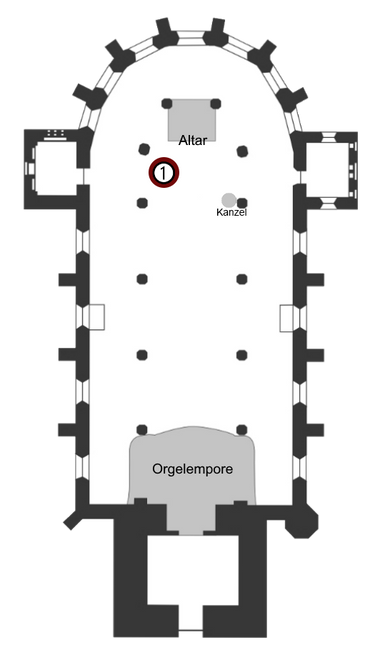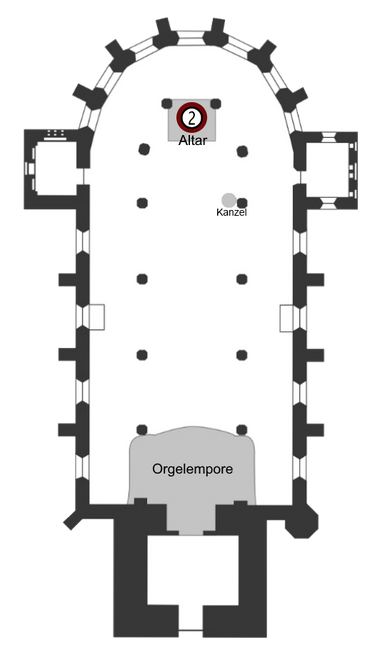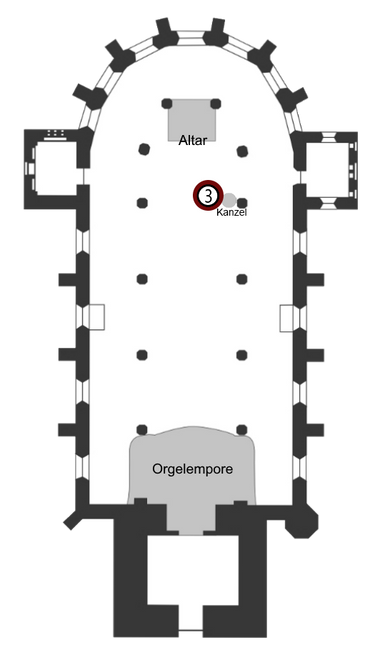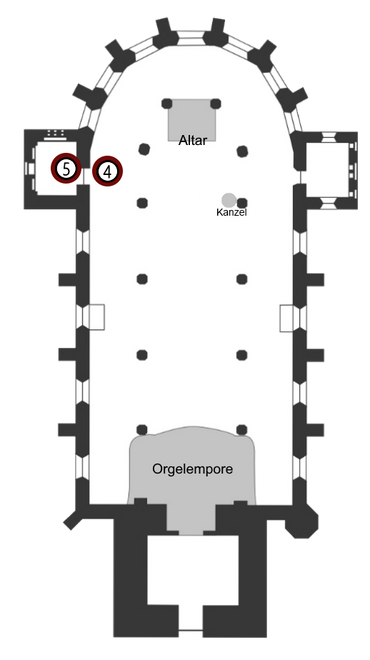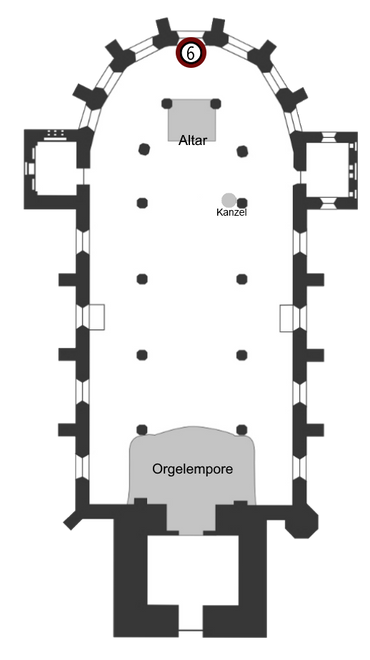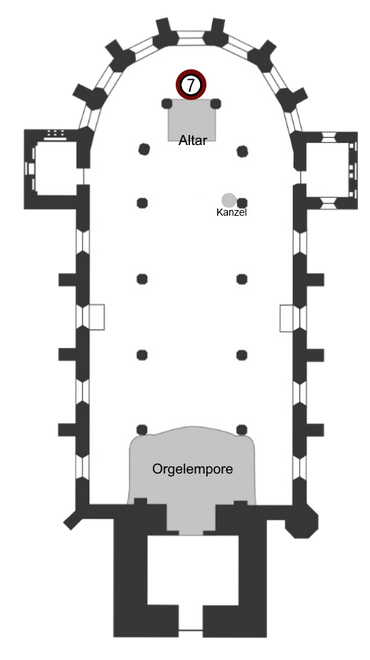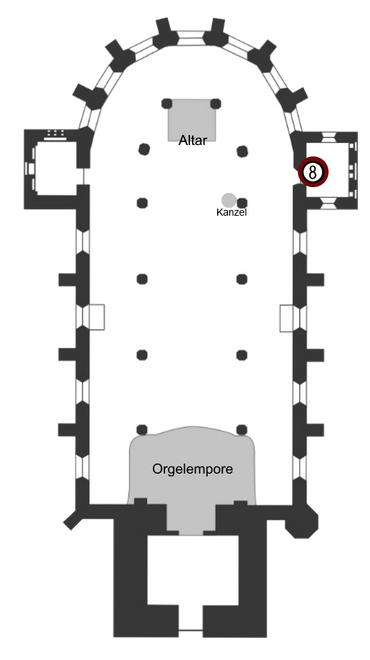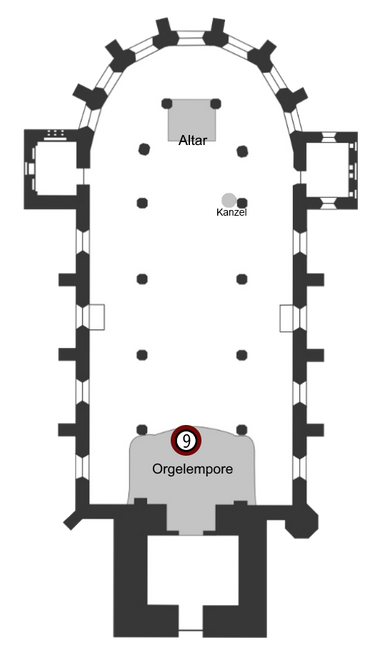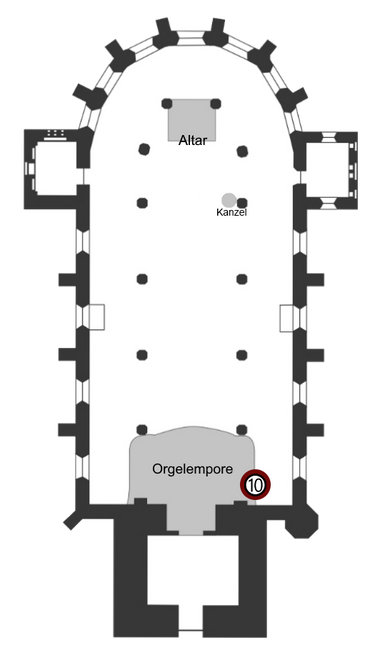

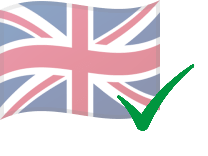
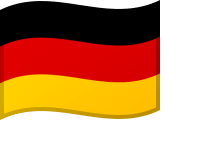
A Brief Guide through St Nicholas Church in Berlin-Spandau
Welcome! You have just entered a church that is one of the oldest in the city of Berlin and the Reformed Church of the March of Brandenburg. The church is dedicated to St Nicholas of Myra, who lived in the 4th Century. This church was erected to the glory of God by the citizens of Spandau. The house of God also invites you to prayer. Take advantage of the silence.
Please avoid anything that may disturb other visitors. Before you begin your tour, you may wish to sit down and let the room’s simple beauty inspire you.
If you are not on site and cannot experience the interior of the church in person, simply take a look online for our interactive 360-degree tour of the St. Nicholas Church.
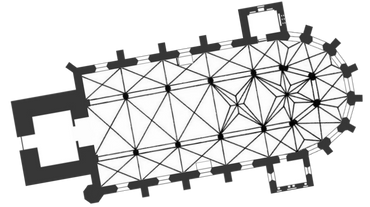
St Nicholas Church is a Gothic hall church with three naves, a polygonal aisle around the choir area, a monumental west tower and side chapels to the north and south of the choir walls. The brick construction was built on a foundation of granite blocks. The weight of the stones is not noticeable when one gazes up to the ribbed vaults that lead to the choir, where the glorious star-formed vault accents its place as the centre of attraction.
Important Dates
End of the 12th Century - The first German merchants’ settlement is built in close proximity to today’s church. This settlement develops quickly into a market town.
1232 - Spandau granted town charter.
1240 - First mention of St Nicholas as ecclesia forensis (Market Church). This forerunner of today’s church was possibly built of stones and wood.
First half of the 14th Century - Construction of today’s church begins.
ca. 1370 - Completion of shell of today’s Gothic hall.
1398 - Endowment of the baptismal font indicates that the room used for worship was finished.
1467/68 - Completion of the massive late Gothic west tower.
1539 - Elector Joachim Il. converts to Protestantism.
1744 - Four years after a devastating town fire, the burned-down church tower receives a new baroque spire.
1806 - Napoleonic troops use St Nicholas Church as an ammunition magazine.
1839 - Neogothic restoration of the church by Karl Friedrich Schinkel.
1944 - During a heavy bombing raid on October 6th, the tower burns out.
1979/96 - Complete interior and exterior restoration of the church. Restoration of the baroque tower view, tower elevation: 77 m.
Interior Furnishings of St Nicholas Church Spandau
The baptismal font ① made out of bronze is the oldest work of art in the church. It is dated 8th September 1398. The font is held by the four evangelists standing on a ring-shaped base. The baptismal font is so large that, earlier, those being baptised could be completely immersed in water. Prussian King Frederick I. discontinued this method of baptism in 1701. The angel figures decorating today’s bronze inset originate from the Schinkel era 1839.
The artistic culmination of the interior is the altar ②, endowed by Rochus Count Lynar in 1582. It stands on the centre line of the church and is elevated to over 8 m. It is made of stone, its sculptures are chiselled from one block and were painted by Hieronymous Rosenbaum. At the centre of the Renaissance altar Christ is portrayed three times: at the Lord’s Supper, as judge of mankind and being crucified. The side panels display portraits of the endowing Lynar family: to the left Count Rochus with his sons, to the right Countess Anna and their daughters.
The pulpit ③ is a master work of Prussian baroque. It was carved from wood ca. 1700. The base is formed by bear claws, the balustrade by three Prussian eagles. Originally the pulpit was in the palace chapel of the Potsdam City Palace.
The crucifixion group ④ is from the period ca. 1500 and can be found in a niche above the grille doors decorated with emblems leading to the Ribbeck Chapel ⑤. The crypt of the Ribbeck family is located under the floor here.
Whoever walks along the aisle around the choir will see a considerable number of old gravestones, epitaphs (stone slabs with dedications to the memory of the departed) and family emblems. They are all reminders of important persons from the city and castle of Spandau. On the outer wall a pre-reformation sacramental niche can be found ⑥.
Directly across from here you can see into the open Lynar family crypt ⑦ Rochus Guerini Count Lynar was born in Tuscany in 1525, fled to France in 1542 because of a blood vendetta and became a Calvinist in 1560. Elector Johann Georg brought him to the March of Brandenburg in 1578 and delegated supervision of construction work on Spandau Citadel to him. Lynar died in Spandau in 1596. He was buried with his family under the altar that he had endowed.
In the side naves and under the organ loft portraits of some of the former pastors of St Nicholas can be seen. At present the sacristy is located in the former south chapel ⑧.
The grand organ ⑨ was given its festive inauguration in 1996. It was built in the workshop Eule in Bautzen/Saxony and has 51 registers with a total of 3638 organ pipes, three keyboards and one pedal mechanism. St Nicholas is one of the parishes in Berlin with special emphasis on church music, offering regular concerts of exceptionally high quality.
On 1st November 1539, in St Nicholas Church, Elector Joachim Ul. received Holy Communion according to the Lutheran rite in both kinds (bread and wine). With this the Protestant reformation was introduced into the entire March of Brandenburg. This important event in church history is commemorated by the painting ⑩ from 1913 and the memorial in front of the church.
Thank you for your visit - Wir danken Ihnen für Ihren Besuch
Should you have any further questions, please contact the attendant

